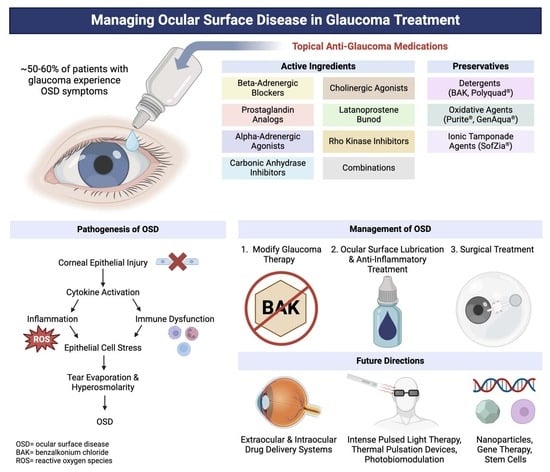| Newly diagnosed treatment-naïve POAG patients vs. those on topical anti-glaucoma medications | A prospective cohort study conducted on 120 eyes with POAG (60 on topical anti-glaucoma drops and 60 treatment-naïve eyes). | At 3, 6, and 12 months, the OSDI score, TBUT, Schirmer’s test, TMH, and TMD had significantly better values in the treatment-naïve group in comparison to the medicated group (p < 0.0001). | Srivastava et al.
India, 2024
[40] |
| Patients with open-angle glaucoma or OHT on topical anti-glaucoma medications vs. healthy subjects | In this cross-sectional study, 75 patients were using topical anti-glaucoma medications and 65 were treatment-naïve subjects. OSDI, Schirmer’s test, TBUT, fluorescein staining, and CET were evaluated. | The treatment group had a significantly shorter TBUT, shorter Schirmer’s test, and greater fluorescein staining than those of the control group (p < 0.05). The mean CET of patients with glaucoma was significantly lower than that of controls in the central, paracentral, mid-peripheral, and peripheral zones (50.6 vs. 53.1 µm; p < 0.001). The number of medications and duration of treatment also affected the CET in all zones (p < 0.05). | Ye et al.
China, 2022
[41] |
| Glaucoma patients on topical anti-glaucoma medications vs. healthy controls | 94 patients with glaucoma on topical medications (study group) and 94 patients in the treatment-naïve control group were assessed using OSDI, TBUT, lissamine green staining, and Schirmer’s test. | OSDI scores were significantly higher in the study group (72.4%) vs. controls (44.6%). Similarly, the study group had decreased tear production (84% vs. 53%, respectively), abnormal TBUT (67.1% vs. 47.8%), and positive lissamine green staining (36.2% vs. 31.8%) compared to the control group. | Pai and Reddy
India, 2018
[42] |
| Patients with POAG or OHT on topical anti-glaucoma medications vs. healthy controls | 211 eyes of patients with POAG or OHT on topical medication were recruited. Controls consisted of 51 eyes. Outcome measures were fluorescein corneal staining score, TMH, TBUT, and OSDI. | Compared to controls, significantly higher OSDI (10.24 vs. 2.5; p < 0.001) and corneal staining (≥1: 64.93% vs. 32.61%; p < 0.001) scores were recorded in the medication group. No significant differences in TBUT and TMH were observed between groups. | Pérez-Bartolomé et al.
Spain, 2017
[43] |
| Glaucoma patients on topical anti-glaucoma medications vs. OHT patients or relatives of glaucoma patients not on topical medications | In this cross-sectional study, 109 participants (79 on topical medications and 30 controls) were evaluated via OSDI, Schirmer’s test, TBUT, and fluorescein staining. | The medication group had significantly shorter TBUT (6.0 vs. 9.5 s; p < 0.03), greater fluorescein staining (1.0 vs. 0; p < 0.001), and higher impression cytology grade than the control group (1.0 vs. 0.6; p < 0.001). | Cvenkel et al.
Slovenia, 2015
[44] |
| Patients with POAG on topical anti-glaucoma medications vs. healthy controls | Age-matched patients were assigned to 2 groups: the glaucoma group (31 patients) and the treatment-naïve control group (30 patients). Each patient was assessed with OSDI, conjunctival/corneal staining, and TBUT. | OSDI scores of the glaucoma group positively correlated to the amount and duration of drops used. The glaucoma group had a higher mean OSDI score than the control group (18.97 vs. 6.25). Abnormal TBUT and staining scores were seen in the glaucoma group compared with the control group (68% vs. 17%). | Saade et al.
USA, 2015
[45] |
| Patients with glaucoma or OHT on 0, 1, or ≥2 topical anti-glaucoma medications | 39 patients treated for glaucoma or OHT and 9 untreated patients were included in this study. Corneal sensitivity was measured using the Cochet-Bonnet esthesiometer, Schirmer’s test, TBUT, corneal and conjunctival fluorescein staining, and OSDI. | Corneal sensitivity of patients treated with IOP-lowering medications was negatively correlated to the number of instillations of P drops (p < 0.001) and duration of treatment (p = 0.001). There was no significant difference in OSDI or Schirmer’s test scores between the groups. | Van Went et al.
France, 2011
[46] |
| Patients with POAG, pseudoexfoliation glaucoma, pigment dispersion glaucoma, or OHT on topical anti-glaucoma medications | This prospective observational study assessed OSDI in 630 patients with POAG, pseudoexfoliation glaucoma, pigment dispersion glaucoma, or OHT who were on topical IOP-lowering medications. | 305 patients (48.4%) had an OSDI score indicating either mild, moderate, or severe OSD symptoms. Higher OSDI scores were observed in patients using multiple IOP-lowering medications (p = 0.0001). | Fechtner et al.
USA, 2010
[47] |
| Patients using P vs. PF topical beta-blocker drops | In a multicenter cross-sectional survey in four European countries, ophthalmologists in private practice enrolled 9658 patients using P or PF beta-blocking eyedrops between 1997 and 2003. Subjective symptoms, conjunctival and palpebral signs, and SPK were assessed before and after a change in therapy. | Palpebral, conjunctival, and corneal signs were significantly more frequent (p < 0.0001) in the P-group than in the PF-group, such as pain or discomfort during instillation (48% vs. 19%), foreign body sensation (42% vs. 15%), stinging or burning (48% vs. 20%), and dry eye sensation (35% vs. 16%). A significant decrease (p < 0.0001) in all ocular symptoms was observed in patients who switched from P to PF eye drops. | Jaenen et al.
Belgium, 2007
[48] |
| Patients with POAG or OHT using P vs. PF topical anti-glaucoma medications | This prospective epidemiological survey was carried out in 1999 by 249 ophthalmologists on 4107 patients. Ocular symptoms, conjunctiva, and cornea were assessed between P and PF eye drops. | All symptoms were more prevalent with P than with PF drops (p < 0.001): discomfort upon instillation (43% vs. 17%), burning-stinging (40% vs. 22%), foreign body sensation (31% vs. 14%), dry eye sensation (23% vs. 14%), and tearing (21% vs. 14%). An increased incidence (>2 times) and duration of ocular signs were seen with P eye drops, which decreased upon switching to PF drops (p < 0.001). | Pisella et al.
France, 2002
[49] |

